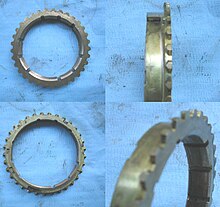Synchronizer ring
Synchronizer rings are part of modern synchronous gears . By means of friction, they bring the gearwheel and shift sleeve of the selected gear to the same speed so that it can be engaged without double- declutching.
functionality
A gearbox has three different speeds of rotation.
- The output shaft of the gearbox is permanently connected to the final drive and therefore rotates proportionally to the vehicle speed . Your speed hardly changes during the shifting process.
- The main transmission shaft rotates with the engine ( crankshaft ) when the clutch is engaged , while the other transmission shafts drag it when the gear is engaged when the clutch is disengaged.
- The auxiliary shaft (s) have a speed that depends on the gear selected.
When switching, the rotational speeds of the sleeve and the gear of the corresponding gear must first be adjusted. This is done by pressing the synchronizer ring in between. The more vigorously you press the gear lever, the more friction is generated and the faster the rotational speeds are adjusted. As soon as both rotate synchronously, you can push the gearshift sleeve practically without force over the ring gear and the gear is engaged.
The engine speed must then be adjusted. By releasing the clutch pedal, friction is generated in the separating clutch between the engine and the transmission until the transmission input shaft and crankshaft are also synchronized and a continuous frictional connection is achieved.
history
Cadillac developed a synchromesh transmission as early as 1928 . Nevertheless, it took decades for the transmissions of all passenger cars to be “fully synchronized”, ie. H. all gears were provided with synchronizer rings. The standard version of the VW Beetle only had a fully synchronized gearbox from November 1964 (VW 1200 A, "Sparkäfer"), i.e. H. While driving, it was also possible to shift down to first gear without double-declutching. Previously, only second to fourth gears were synchronized. The gearboxes of trucks and tractors were also synchronized relatively late (1970s / 80s). Nowadays, the synchronization of automated truck transmissions is often dispensed with and synchronization is instead established through interventions in the engine management system and, when shifting up, possibly also through a multi-disc brake in the transmission.
A synchronization of the higher gears in electronically controlled transmissions is not absolutely necessary, which is favored by the usual progressive gear stepping (smaller speed jumps in higher gears).
Until the use of synchronous rings is called had declutching when shifting to a lower gear and double clutching apply to a higher gear.
Manufacturing
Synchronizer rings are made of metal and can be provided with friction linings. Common metals for synchronizer ring production are brass and steel . The friction linings can be made of molybdenum , iron , bronze or carbon (“carbon”).
The synchronizer rings are forged from raw material in the form of semi-finished products or alternatively produced by sheet metal forming . Under sheet metal forming is understood as punching out the blank of sheet metal strips with subsequent processing in progressive - or transfer tool .
Friction linings serve as a wear protection layer and usually consist of thermally sprayed molybdenum; alternatively, cheaper and more efficient iron or bronze sintered friction layers can be used. Carbon-coated synchronizer rings are particularly wear-resistant and offer very good frictional behavior, but due to their higher price they are mainly used in high-performance transmissions.
